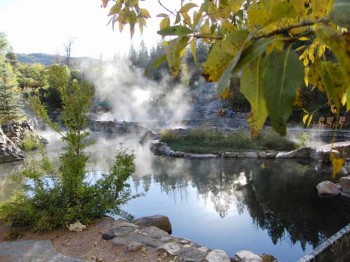
This blog is just the small-potatoes-rambling of one over-exuberant semi-neophyte foraging addict, but I swear, wild food must be en vogue or something—because in the last four months I have received not one or two but three different emails from producers seeking to create TV or web shows about foraging.
One inquired as to whether my collecting missions require acts of bravery. Acts of bravery? I was inclined to reply in the negative, but, eager to please, I dug deep and ventured this response: “Does hanging off a mountainside to collect currants count?” (It’s not that I have to hang off the mountainside; it’s just that that’s where the best currants are.) I got the sense that he appreciated my effort but found the answer wanting, however.
Next he asked whether I travel worldwide for special wild foods. “Um, no,” I replied. Clearly my hobby is less sexy than TV might hope. “Mostly I forage locally where I live,” I explained. Really I’m just a poor fool working 10 jobs, scavenging my food from the wild so I can afford to live in paradise, and banging away at the keyboard about things that interest me whenever I get the chance.
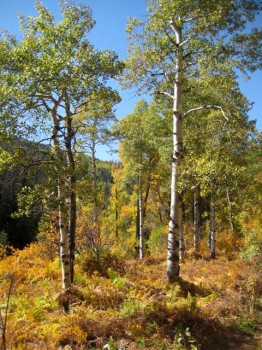
Even if I did have a budget for foreign foraging travel, I’m not sure how I’d feel about the idea. So many things appeal to me about foraging locally—the environmental benefit of reduced fossil fuel use for food procurement, the zero economic impact that free food has on my “pocketbook,” and my increased connection to this place I call home, to name a few.
That is not to say, however, that I don’t bring my foraging gear—some pint containers, bags, scissors, and books—on the road with me when I travel for other reasons. I am an opportunistic forager. If I’m bound for unfamiliar territory anyway, there’s no way I’m missing out on the plant life.
Unintentional Foraging Vacation
So last week, we went to Strawberry Park Hot Springs in Steamboat to soak and relax and celebrate the end of my summer writing gig. I had never been there before and our timing was perfect to hit the springs while the aspen change was at its peak. It was absolutely stunning.
Still—you know the first thing I noticed, even before the springs themselves? Chokecherries hanging by the check-in wagon. And the second? Plump, ripe, near-translucent red rose hips hanging over the picnic table at our campsite. The third? An oak tree busting forth with tiny albeit beautiful brown and green acorns above the stone steps to the washroom.
Gregg succeeded in tearing me away from the plants for our first soak, but shortly thereafter I was at it again—waking up early both mornings to get my plant expeditions out of the way so I could enjoy relaxing at the pools (with my stack of wild edible books, of course).
White Berries: To Eat or Not to Eat?
Fall is good berry foraging in the Steamboat area, apparently—for the trees at the springs were laden with various kinds of ripe, juicy, mouthwatering fruits. “Can I eat some of your berries?” I asked the attendant.
“Sure,” he replied. “Just don’t eat the wrong berries; there are definitely some you don’t want to eat,” he said, indicating the white berries in particular.
White berries do seem to have a bad rap. On a recent visit to my local coffee shop I spied a card pertaining to berry-eating at the top of the deck in the “Worst Case Scenario Survival Game.” On “How to Hunt for Berries in the Wilderness,” the game says “Most blue and black berries are edible, while only some red ones are edible, and most white ones are poisonous.”
Perhaps this is true, but I’m fairly certain the white berries at the springs belonged to red osier dogwood (Cornus sericea), the leaves of which were combined with kinnikinnik to make a “smoking mixture” by native people, according to Betty Derig and Margaret Fuller in Wild Berries of the West (2001). The authors also state, however, that “the bitter berries of red osier dogwood are edible but not palatable.”
“Although sometimes consumed by Indian tribes of the Northwest, the berries (of red osier dogwood) do not taste good and may be toxic if eaten in large quantities,” writes Gregory Tilford in Edible and Medicinal Plants of the West (1997).
Hmm. It’s not like palatability has ever stopped me from tasting a wild plant before.
Still, in the end, something did stop me from trying those white berries—for as I spent two days traipsing around the fruitful grounds, I was far too distracted by more promising prospects. It’s so nice to have the problem of too many wild edibles competing for my attention.
The attendant’s was fair warning, however, that berry identification and consumption is not a matter to be taken lightly. (Again: Please cross-reference anything you read or see here with appropriate identification guides prior to consuming.) Without further ado, then, here is an overview and notes on some of the berry fruits we found and tried:
Chokecherries
The chokecherries (Prunus species) seemed to be fully ripe for our visit—plump and dark red-black in color, dangling out of reach above my head in most places. I didn’t find them in any quantity but there are likely still fruitful patches out there. They looked a lot more appetizing than they tasted, however—which was mouth-puckeringly astringent despite a small burst of sweet. Still, I’d make jam out them. Lately, I’ll make jam out of anything.
One thing to keep in mind is that chokecherry pits, leaves, and stems contain cyanogenic glycosides that can form toxic hydrogen cyanide under certain conditions, according to a clinical toxicology presentation from the veterinary program at Colorado State University. HCN poisoning from leaves and stems of chokecherry, serviceberry, elderberry, and other plants can result in sudden livestock death. Although humans are less susceptible than certain ruminants, these are not parts to be eating from these plants.
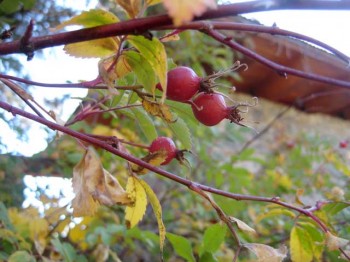
Rose Hips
Not only were the rose hips (Rosa species) ripe and enticing, but they were also right outside the door of our covered wagon, so I couldn’t keep myself from picking and nibbling on their soft exteriors. Cattail Bob Seebeck says “fresh, ripe rose hips are the most potent source of vitamin C in the Rockies” and that “one rose hip is equal to about 500 mg of vitamin C.” If that doesn’t help me finally kick this cold, I don’t know what will. My initial experiment with rose hip jelly last year was not all that successful, but I’ll link to it in case you want to review. Here’s hoping this year’s concoction works out a little better…
Hawthorn
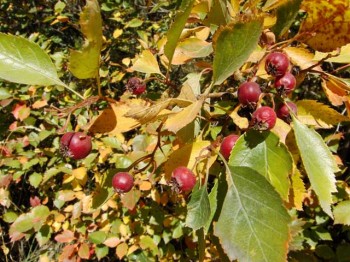
Related to wild rose is hawthorn (Crataegus species), also in the Rosaceae family, which might explain why our attendant mistook the red berries of the local hawthorn trees for rose hips. Whereas the rose bushes had numerous, small, thin thorns, however, the hawthorn trees had big, inch-long, spikes. Derig and Fuller explain that coastal tribes used these thorns for “making rakes to catch herring and for lancing boils and piercing ears.”
Akin to tiny apples, the berries range in color from red to purple-black depending on species. According to Derig and Fuller, they are edible “but taste sweet, insipid, bitter, or astringent, varying from tree to tree.” The ones we tried were red and somewhat mealy and tasteless raw, in keeping with the authors’ assertion that hawthorn berries were not a choice food for many native people. Still, the day I have the opportunity to collect a good hawthorn bounty, I intend to find a use for them.
In his entry on chokecherries in The Forager’s Harvest (2006), Samuel Thayer describes the also-thorny buckthorn (Rhamnus species) as a toxic-fruit-producing tree, explaining that glossy Rhamnus frangula fruits superficially resemble chokecherries but contain numerous seeds to the cherry’s one, and that common buckthorn (Rhamnus cathartica) is a “powerful cathartic.”
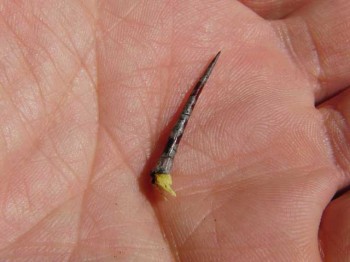
I mention all this to say that in Rhamnus’ range, one should be careful not to be deceived by either its cherry-like or hawthorn-thorn-like appearance. Though the berries range from red to dark-black, Rhamnus is one genus whose berries don’t necessarily conform to the notion that “most blue and black berries are edible.”
While catharsis may seem appealing in the “cleansing” or “purification” sense of the word, Wikipedia explains that “in medicine, a cathartic is a substance that accelerates defecation.”
Serviceberry
Of all the Steamboat berries, I am most excited about serviceberry (Amelanchier species, also in the rose family), despite the fact that we were only able to scavenge a handful of berries to taste, as the season’s peak was past in that location. “I have found a few trees whose fruit was truly distasteful,” Thayer (2006) says of the serviceberry, “but more commonly they bear what seems like a gift straight from heaven.” The latter was definitely my experience too.
“They’re not better than huckleberries,” Gregg insisted, but I begged to differ as I scaled steep hillsides in my flip flops trying to score any last dangling berry I spied. Serviceberries—watch out! Next year, you and I have some acquainting to do. Mmm!
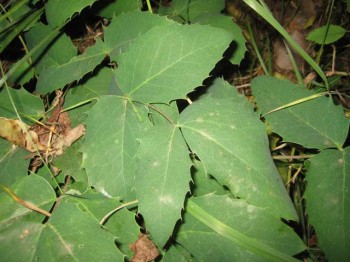
Oregon grapes
We found powder-blue Oregon grapes aka holly grapes (Mahonia species) low to the ground amidst the grasses alongside a trail into the forest. They’re tart and I preferred to spit out the seeds, but as tart fruits make good jellies and pies, I’d love to try some recipes one day with Oregon grapes. Derig and Fuller’s book has one for Oregon grape jelly. True to the plant’s name, the leaves are holly-like, which in my lack of experience with this plant I found unusual.
False Solomon’s Seal
The other berries I found trailside were the red, sticky-sweet berries of false Solomon’s seal, aka Solomon’s plume (Maianthemum species). On less mature plants nearby, the berries were speckled, but on the plants with yellow-brown leaves, they were fully red and ripe and somewhat translucent.
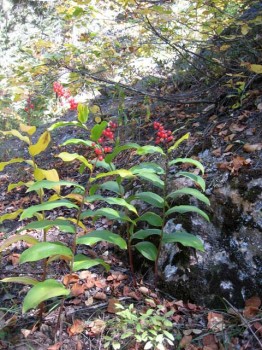
This was an exciting find for me as I grew up with this plant back east, and it was one of those that fit into the category of red berries your mom always warned you not to eat. But there it was in several of my books—so of course I had to venture a try. I found the berries to be sweet and yummy, though they have a seed inside that would need to be removed for food preparation.
In Nature’s Garden (2010), Thayer makes a distinction between eastern and western varieties of Solomon’s plume, saying that the western berries he tried were better tasting than those he found in the East—so maybe it’s a good thing it took this long for me to try them. Derig and Fuller say “the bitterness of false Solomon’s seal berries protects us from eating enough to cause severe diarrhea—a possible reaction,” though there is no mention of diarrhea in Thayer’s account.
I collected a bunch of these so after I eat them, if diarrhea occurs, I’ll be sure to post a follow-up in all the gory detail, hopefully in 2,000 words or less.

Hey, i like your posts- just wanted to offer a word of encouragement concerning chokecherries, they will often turn black before they’re fully ripe, leaving that astringency you mentioned, but at their peak, they are very good, and only slightly astringent, we eat loads of them in season, and they make wonderful fruit leather- so don’t give up on them… and thanks for all th’ great posts
your fellow forager, rico
@Rico: Ok, I won’t give up on the chokecherries:) !! Fruit leather, mmm… Thanks for the kind words.
And Sam Thayer says this about the white berries thing: “I hate those…rules. Baneberry: toxic. Symphoriocarpos: mildly toxic or inedible. Red osier dogwood: edible but bitter but some people develop a taste for them. Creeping snowberry: delicious.” So yeah, I guess I have to try the red osier dogwood berries next time… Thanks, Sam:)
Hi Erica:
This is an update of what I just posted that didn’t appear:
I don’t know if any mysteries mentioned on this webpage were solved long ago, but here are some thoughts:
1. Cyanogenic compounds can be tasted and smelled. They smell like the smell of most/all Prunus & Malus plants when scratching the bark. This is similar to the smell of almond extract, almond scented Russulas (also containing cyanogenic chemicals, though not in toxic proportions), and maraschino cherries. The taste is mildly to moderately bitter while also pleasantly and strongly like the smell. If you get a rose hip and wonder if its seeds might contain significant amounts of cyanogenic compounds, then you have only to taste & smell to figure it out. As to natives eating Prunus & Malus seeds, like any issue of what is toxicity, it is a matter of how much. For example, sweet apricot kernels contain cyanogenic compounds, but not enough to matter in most situations, but bitter ones can kill a person if eaten in quantity (I forget the amount, but perhaps 1/3lb bag of them). People eat apple seeds, almonds, apricot seeds, black cherry seeds, etc., but usually in very safe amounts (some claim anti-cancer reasons to eat them..). I eat all of the above, but won’t have any significant fraction of a lb of them at any time, which means they are safe and non-toxic at these levels.
Also, cyanogenic compounds break down with cooking, so if cooked one can eat lbs of them w/impunity.
2. What were the effects on you from the Maianthemum berries? Did you ID the Maianthemum species you ate from?
—
Sam Schaperow, M.S.
https://groups.yahoo.com/group/PlantForagers
Erica Marciniec · Breckenridge, Colorado
Hi Sam, thanks for the info on cyanogenic compounds. Yes, I have done much more research on those since penning this old piece. As you say, they break down in cooking, and apparently with heat/drying too, explaining why native folks could crush chokecherries, pits included, and eat them in crunchy, sun-dried cakes without succumbing. But the smell bit is something I hadn’t thought much about, cheers.
That anti-cancer laetrile drama is something. Some saying there was a coverup to positive findings, some saying there are no anti-cancer benefits and it is too risky to eat apricot kernels in quantity. Interesting stuff.
The species of Solomon’s plume whose berries I ate was Maianthemum amplexicaule (Colorado Flora, Weber & Wittmann 2012 ed.). The authors indicate the FNA considers it a variety of M. racemosum, but that our species is diploid whereas M. racemosum is triploid; they also say they do not intergrade. I cooked a bunch of berries down with sugar and screened out the seeds, making a bright red sauce that I used in a pan-Asian stir fry. Yummy. No ill effects.
I make chokecherry habanero jelly..absolutely amazing
would you like the recipe?
Sure that sounds lovely, thank you:)
Hi Patti, sorry for the delay responding. If you see this, yes, I’d love the recipe!